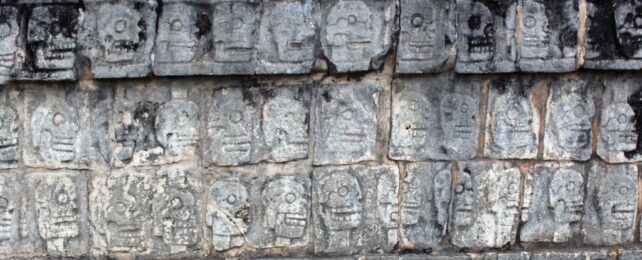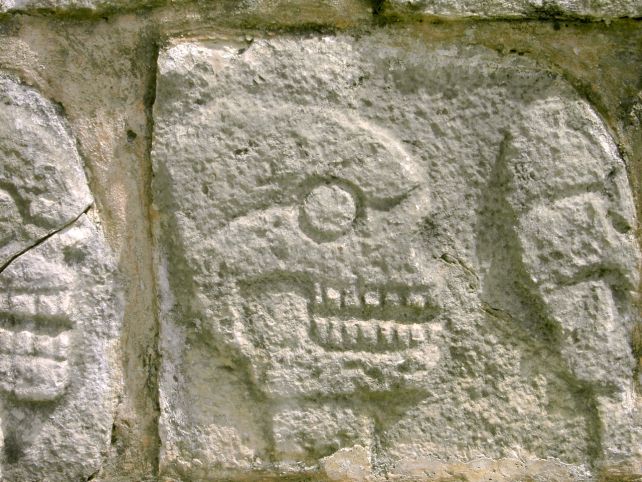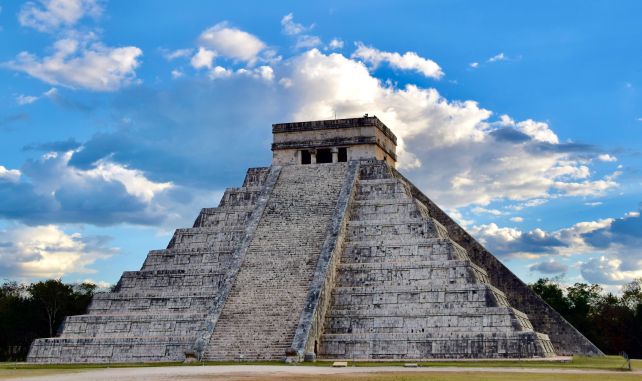
Understand that we had it all wrong here. Makes you wonder how much else our historical narratives have gotten just as wrong.
A community sacrificed a couple of boys every year for five hundred years and that was that. DNA figured that out.
The unexpected surprise is that we are recovering DNA in our library of archeological sites and DNA is providing a useful new voice on the data.
I cannot wait to see DNA from the Baltic linked to the Greeks.
DNA Analysis Overturns Myths of Maya Empire's Child Sacrifice Rituals
13 June 2024
Detail of a reconstructed stone tzompantli, or skull rack, at Chichén Itzá
https://www.sciencealert.com/dna-analysis-overturns-myths-of-maya-empires-child-sacrifice-rituals?
In the height of the Maya empire, the victims of human child sacrifice appear to have been very carefully selected.
According to a new analysis of ancient DNA led by researchers from the Max Planck Institute for Evolutionary Anthropology, the chosen victims have something in common. The remains of 64 individuals found inside a subterranean chamber known as a chultún all belonged to young boys, many of whom were closely related. Among them, two sets of identical twins.
It's a discovery that contradicts the common notion that sacrifice victims tended to be young girls – an important insight into child sacrifice in Chichén Itzá, deep in the heart of Mexico's Yucatan Peninsula.
"The similar ages and diets of the male children, their close genetic relatedness, and the fact that they were interred in the same place for more than 200 years point to the chultún as a post-sacrificial burial site, with the sacrificed individuals having been selected for a specific reason," says archaeologist Oana Del Castillo-Chávez of Centro INAH Yucatán.
We've known about the tragic fate of the children in the chultún since 1967, when excavations revealed the chamber and its grisly secrets. Likely once a water cistern, the chultún had been enlarged to connect to a nearby cave, a type of natural feature known to be connected to ritual sacrifice.

A detail of the tzompantli, which was used to display heads, at the center of Chichén Itzá. (Christina Warriner)
Within the chamber lay the remains of more than 100 children. But the sex of juvenile humans is difficult to determine merely by the shape of the bones, so the notion that the victims were female remained unchallenged.
Recently, however, evidence emerged suggesting that at least some of the victims were male. And with the application of more sophisticated technology, we've been able to retrieve and sequence ancient DNA that would have been impossible to study before.
Led by immunogeneticist Rodrigo Barquera, a team of researchers set about studying the Chichén Itzá bones, to learn and share the stories of the children to whom they belonged.
The first step was dating. This revealed that the chultún had been in use for the interment of human remains for more than 500 years, from the 7th to 12th centuries CE. Most of the remains, however, were deposited over a 200-year period, between 800 and 1000 CE – the height of the Chichén Itzá culture.
Next, the researchers performed analysis of the bones from 64 individuals, including genetic analysis, and an analysis of isotope ratios retrieved from bone collagen.
The isotope analysis revealed not just what the children ate, but the source of that food. Previous studies had suggested that some of the children were brought in from elsewhere, leading the researchers to wonder from whence they came. Since elements such as carbon and nitrogen in their diet would have replaced some of the material from which their collagen forms, the ratios of these isotopes in their remains could be linked to the location of a food source.
The big surprise was that the children all ate food that would have been found locally, meaning they were all from local communities.

El Castillo, the temple to the god Kukulcan, one of the largest structures in Chichén Itzá. (Johannes Krause)
But there were more surprises in store. All of the bones tested were from male children, and at least a quarter of them were closely related, with a similar diet, suggesting that they lived in the same household.
"Most surprisingly, we identified two pairs of identical twins," says archaeogeneticist Kathrin Nägele of the Max Planck Institute for Evolutionary Anthropology. "We can say this with certainty because our sampling strategy ensured we would not duplicate individuals."
This suggests the boys were likely being selected in pairs for rituals, the researchers say, with twins perhaps being especially desirable. Identical twins only happen by chance in 0.4 percent of the general population, so two pairs in the chultún is more than would be expected.
The Maya sacred text Popol Vuh recounts the tale of the Hero Twins, Hunahpu and Xbalanque, who avenge the sacrificial death of their father and uncle, themselves twins, by undergoing repeated cycles of ritual sacrifice and resurrection in order to trick the gods of the underworld.
"Early 20th century accounts falsely popularized lurid tales of young women and girls being sacrificed at the site," says anthropologist Christina Warinner of Harvard University.
"This study, conducted as a close international collaboration, turns that story on its head and reveals the deep connections between ritual sacrifice and the cycles of human death and rebirth described in sacred Maya texts."
No comments:
Post a Comment